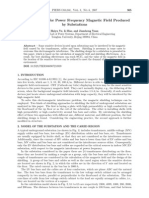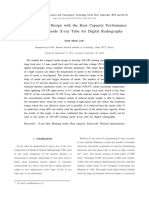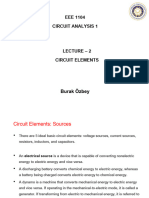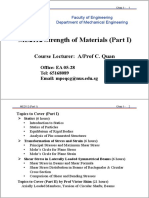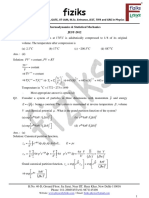Compact Large-Range Cryogenic Scanraer: Department Physics, The University Michigan, Ann Arbol Michigan 48109
Compact Large-Range Cryogenic Scanraer: Department Physics, The University Michigan, Ann Arbol Michigan 48109
Uploaded by
Muraleetharan BoopathiCopyright:
Available Formats
Compact Large-Range Cryogenic Scanraer: Department Physics, The University Michigan, Ann Arbol Michigan 48109
Compact Large-Range Cryogenic Scanraer: Department Physics, The University Michigan, Ann Arbol Michigan 48109
Uploaded by
Muraleetharan BoopathiOriginal Title
Copyright
Available Formats
Share this document
Did you find this document useful?
Is this content inappropriate?
Copyright:
Available Formats
Compact Large-Range Cryogenic Scanraer: Department Physics, The University Michigan, Ann Arbol Michigan 48109
Compact Large-Range Cryogenic Scanraer: Department Physics, The University Michigan, Ann Arbol Michigan 48109
Uploaded by
Muraleetharan BoopathiCopyright:
Available Formats
Compact
large-range
cryogenic
scanraer
Jeffrey Siegel, Jeff Witt, Naia Venturi, and Stuart Field
Department of Physics, The University of Michigan, Ann Arbol; Michigan 48109
(Received 16 September 1994; accepted for publication 18 November 1994) We describe the construction and operation of a large-range piezoelectric scanner, suitable for various scanning probe microscopies such as magnetic force, atomic force, and Hall probe microscopies. The instrument is compact and inherently thermally compensated. At room temperature, it has a range of over 2 mm; this range is reduced to 275 ,um at 4.2 K. 0 299.5 American Institute of Physics.
I. INTRODUCTION Because of its subangstrom resolution, scanning tunneling microscopy (STM) places extreme requirements of stability and resonant frequency on its scanning stage. Binnig and Smith developed an elegant piezoelectric tube scanner which compactly satisfies these requirements. The scan range of tube scanners tends to be small, usually much less than a micron, ideally suited for the small fields of view needed for STM. More recently, there have been developed a great variety of novel scanning probe microscopies, such as atomic force,2 magnetic force,3 near-field optical,4 and Hall probe microscopies. Often, these probes image spatial variations in aparameter-magnetic field, for instance-on a scale much larger than the angstrom scale typically encountered with STM. Further, many of these microscopies have been adapted to cryogenic temperatures, where the response of the piezoelectric elements commonly used for stage motion is even further reduced. Thus there is a need for scanning stages which can reliably scan over ranges of many microns. There have been several approaches to designing scanners with x-y ranges in the ten to hundred micron range. Several groups have simply used very long piezo elements.6y7 Other designs use piezoelectric benders and other types -l3 of electromechanical devices 4*15 in various geometries to improve upon the inherent limited range of tubes. Purely mechanical scanning techniques have also been used.16 All 17 these designs suffer from either a complex design scheme, or from being large and unwieldy. We describe here a scanning stage which uses piezo benders to scan over a range of 2 mm at room temperature and 275 pm at 4.2 K. It is compact, with a length of 2.5 in., and will easily fit inside a 1.25 in. diameter tube. II. INSTRUMENT DESIGN As shown in Fig. l(a), the scanner consists of four piezo benders connected by three Macor ceramic pieces: a base, a secondary stage, and a scanning head. Macor is used because it is easy to machine and it has a coefficient of thermal expansion similar to that of piezoelectric material. We find that this thermal match allows the piezos to be directly glued to the Macor pieces using cyanoacrylate (super) glue, which allows for easy disassembly for repairs or modifications. We have found such joints to be reliable upon thermal cycling to cryogenic temperatures. The base, which remains fixed, has a rectangular hole large enough to fit the scanning
2520 Rev. Sci. Instrum. 66 (3), March 1995
head and give enough room for the head x and y translas tion. The ends of two of the benders are glued to opposite sides of the inside of this hole, and the secondary stage is glued to the other ends of these benders. With such an arrangement, the secondary stage moves in what we call the x direction when voltage is applied to these benders. In a similar fashion, the other two benders join the secondary stage to the scanning head, allowing y motion of the scanning head relative to the secondary stage. The benders must have their electrodes segmented in a particular way, as shown in Fig. l(b). With this segmentation, the lower half of the bender curves in one direction upon application of a voltage, and the upper half in the opposite direction. In this way, both ends of each bender remain at all times perpendicular to the direction of motion, as required by the boundary conditions imposed by the Macor pieces to which they are glued. A stage made with unsegmented benders will not move at all. Also shown in Fig. l(b) is the method in which our benders were wired. The lower segment on one face of the bender is connected to the upper face of the other side, and the two remaining segments are connected to each other. Thus there are two electrically independent electrodes. The translational response of a bender with segmented electrodes as described above is x= ds1VL2/T2 (half the response of an unsegmented benderr8), where V is the voltage difference applied between the outer electrodes, L is the length of the bender, T its thickness, and d31 the piezoelectric constant (strain per applied electric field). For a tube, the response is x=2 fid31VL2/(s-DT), with D the diameter of the tube and T its wall thickness. Thus for identical materials and equal thicknesses, the response of the bender is larger than that of a tube by a factor of 7rD/(2&T), which is about 14 for a typical diameter-to-thickness ratio of 12.5 (0.25 in. diameter, 0.020 in. thick). Conversely, a tube would have to be 3.7 times as long as a bender to achieve an equivalent motion. Having such a large scanning range introduces some problems not encountered with shorter range scanners. In particular the resonant frequency in the directions of x and y motion can be very low. The resonant frequency of two flat plates constrained to be parallel to each other is 0.262(T/L2) dm,z where Yrr is the bulk modulus of the piezo material and p its density. For our benders, this value comes out to be 97 Hz. However, the actual resonant frequency is lowered due to additional mass on the free ends,
Q 1995 American institute of Physics
0034-6746/95/66(3)/2520/4/$6.00
Scanning head
x Piezo benders \ y Piezo benders
Secondary stage ~
FIG. 2. An 800 pm square room temperature image of a microfabricated test structure, taken using a commercial AJ?%ltip. Only one-third the maxim u m possible range was used for this image, so that the full room temperature range is expected to be about 2.2 mm.
FIG. 1. (,a) Schematic of the scanner, showing the four bender piezos connected via Macor stages, and (b) the electrode sectioning scheme and wiring for one bender.
which for the x translation stage is the entire mass of the y stage. In comparison, the resonant frequency of a thin-walled tube is 0.199[D/L2)dm. In terms of translational sensitivity s (=x/v>, the resonant frequency of a tube is compared to 0.262d31dm/(sT) Q.0895d31~l(sT), for the benders. So the resonant frequency for a given translational semitivity is actually greater for benders than for a tube. Another consideration for a large scanning range is z motion of the scanning head. As the benders bend away from their equilibrium position x= 0, they must move in the z direction a distance Az=2x l(3L) to lowest order. With a large scan range, this z motion can be significant-13 ,um for our scanner with a 2.2 m m range. III. EXPERIMENTAL RESULTS The benders we used on our scanning stage are 2.5 in. long, 0.25 in. wide, and 020 in. thick and have a measured small-signal dfl of 2.0 &V. The voltage to control the motion comes from a high-voltage amplifier that can provide up to +150 V. To achieve maximum motion we apply a voltage to one electrode and the opposite voltage to the opposite electrode. The voltage difference between the electrodes can therefore swing between -t300 V and -300 V. These voltages produce the maximum electric field which may be applied across the benders without risk of depoling them. Figure 2 shows a room temperature image of a microfabricated test structure, made using a commercial atomic force microscope @FM) tip. Here the applied voltage is 255 V, about one third the maximum voltage. The scan suffers from some nonlinearity, so that the true area scanned is not quite square.
Rev. Sci. Instrum., Vol. 66, No. 3, March 1995
Measurements of this structure with an optical microscope show that the scan range is about 800 /..UILThe resolution is clearly limited only by the 3.1 ,um pixel size of the 256x2.56 pixel scan. We apply only 255 V for this room temperature scan because the scan head was designed mainly for cryogenic use, where the bender motion is less, and at room temperature the scan head hits the base at applied voltages of greater than f55 V. Making a linear extrapolation to + 150 V would yield a room temperature range of around 2.2 mm. We have also measured the room temperature resonant frequencies and vibrational motion of the stage in the x and y directions using an optical interferometer. All measurements were performed in air with the stage mounted on a floating optical table. Figure 3 shows the amplitude response of the scanner to a small sinusoidal voltage. The scanner has a resonance at about 45 Hz in the x direction, and at about 73 Hz in the y direction. The x resonance is lower since the x benders carry the extra mass of the y piezos. Although these frequencies are low compared to small tube scanners (which have a much smaller range), they appear entirely adequate for the kinds of scans typically made with these large ranges. Also of interest is the fluctuation of the scan head when no voltage is applied, due to mechanical noise coupling into the system. The amount of noise is difficult to measure, but the scanner mounted in air on an optical table is a typical operating regime. With the voltage leads to the piezos grounded, we measured rms deviations of the scanner head of 4.5 nm in the x direction and 5.7 nm in y. These values are far below the size of any pixel one might expect in operation of such a large-range scanner. Indeed, when the high voltage amplifier was attached but kept at nominally zero volts, the rms displacement noise went up by a factor of about 5, showing that
Cryogenic scanner 2521
x response
1. A
frequency (Hz)
FIG. 3. The amplitude response of the scanner.
in this case amplifier noise was more important than mechanical noise. For many applications, some form of z motion is required. In principle, a voltage proportional to the desired z motion could be added to the outer electrodes of all the benders, causing them to lengthen. The addition of such a voltage, however, will limit the maximum x-y excursion of the scanner? since the depoling field will be reached for smaller values of the x or y driving voltages. Further, the amount of z motion obtainable this way is quite small compared with the large x-y motions. Thus, we have found that it is usually easiest to add a short bender, either on the scanner head or on the fixed part of the microscope, to effect z motion. In this way, large z motions can be obtained with relatively high resonant frequencies while being completely decoupled from the x-y motion. IV. LOW TEMPERATURE OPERATION The main design goal of this scanner was to get large scanning ranges even at cryogenic temperatures, where dS1 for piezoceramics decreases by roughly an order of magnitude relative to room temperature. Our design has several advantages for low temperature work. First, of course, is its large range at cryogenic temperatures. It is also quite compact, with the Macor base, the widest part of the scanner, having a diameter of only 1.125 in., making the instrument small enoughto be used inside a storage Dewar or superconducting solenoid. Finally, the design is inherently temperature compensated. Even though the length of the benders changes due to thermal contraction upon cooling, the scanning head does not move relative to the base. This is because the mechanical path from the base to the secondary stage is made of the same piezo material as the path from the secondary stage to the scanning platform. We have taken images of the same sample as in Fig. 2, but at 4.2 K. Comparison of the two images indicates a total scan range (applying now the maximum t150 V) of
2522 Rev. Sci. Instrum., Vol. 66, No. 3, March 1995
FIG. 4. A 4.2 K scanning Hall probe image of a 100 q thick Pb film. At 200 G, this tilm shbws the laminar normal (dark) and superconducting (bright) domains expected in type-1 films with large demagnetization factors. The image is 230 pm on a side.
275 ,um. Thus the response of our piezos decreases by a factor of 8. This scan range is much greater than that reported for a large-range piezoelectric tube scanner,5 which scanned a 9 r(~msquare at cryogenic temperatures. Our scanner large range shouId allow for imaging a wide range of s intermediate-scale physical systems at cryogenic temperatures. As an example, Fig. 4 shows the magnetic field above a 100 ,um thick Pb film at 4.2 K in a magnetic field of 200 G. This image was taken using a 2X2 ,um microfabricated GaAs Hall probe, and shows the normal and superconducting lamenae expected in type-1 superconductors with large demagnitization factors. The relatively large size of these lamenae precludes their observation with conventional smallrange tube scanners. In summary, we have designed, constructed, and demonstrated the capabilities of a compact, large-range piezoeleo tric scanner suitable for operation at cryogenic temperatures. This scanner may find applications in a variety of novel scanning microscopies which require much larger scan ranges than are possible using standard tube scanners. ACKNOWLEDGMENTS This work was supported in part by the NSF under Grant No. DMR-92-22541, and was performed in part at the National Nanofabrication Facility, which is supported by the NSF under Grant No. ECS-8619049, Cornell University, and industrial affiliates.
G. Binnig and D. R E. Smith, Rev. Sci. Instrum 57, 1688 (1986). Binnig, C. F. Quate, and C. Gerber, Phys. Rev. Lett. 56, 930 (1986). G. 3Y. Martin and H. K. Wickramasinghe, Appl. Phys. L&t. 50, 1455 (1987). Betzia, J. K. Trautman, T. D. Harris, 3. S. Weiner, and R. L. Kostelak, E. Science 251, 1468 (1991): M. Chang, H. D. Hallen, L. Harriot, H. F. Hess, H. L. Kao, R. E. A. Cryogenic scanner
Miller, R. Wolfe, J. van der Ziel, and T. Y. Chang, Appl. Phys. Lett. 61, 1974 (1992). R. Garcia Canti and M. A. Huerta Garnica, J. Vat. Sci. TechnoI. A 8,354 i1990). aV K. Adamchuk. A. V. Ermakov, and S. I. Fedoseenko, Uitramicroscopy 42-44, 1602 (1992). 0. Wantanabe, K. Tanaka, and A. Sakai, J. Vat. Sci. Technol. A 8,327 M. (1990). 9M. A. McCord and R. F. W. Pease,Appl. Phys. I&t. 50, 569 (1987). Muralt, D. W. Pohl, and W. Denk, IBM J. Res. Devlop. 30, 443 (1986). OP. tlB. L. Blackford, D. C. Dahn, and M. H. Jericho, Rev. Sci. Instrum. 58, 1343 (1987). J. Burger, S. C. Meepagaia, and E. L. Wolf, Rev. Sci. Instrum. 60, 735 (1989).
131J.Diirig, D. Pohl, and F. Rohner, IBM J. Res. Devlop. 30, 478 (1986). 14R. Garcia Can& and M. A. Huerta Gamica, Surf. Sci. 181, 216 (1987). J. E. Yao, J. He, G. Y. Shang, Y. L. Kuang, J. Wei, K. Zeng, K. C. Lin, J. W. Dai, and Y. X. Su., in International Symposium on Electron Microscopy, edited by K. Kuo and J. Yao (World Scientific, Singapore, 1991), p. 81. t6D. A. Brawner and N. P. Ong, J. Appl. Phys. 73, 3890 (1993). t7R. N. Goren and M. Tinkham, J. Low Temp. Phys. 5,465 (1971). I8 From catalog, Vernitron Piezoelectric Division, Bedford, OH. 19C. J. Chen, Appl. Phys. L&t. 60, 132 (1992). O D. Blevins, Formulas for Natural Frequency and Mode Shape (Krieger, R. Florida, 1979), p. 221. lM. E. Taylor, Rev. Sci. Instrum. 64, 154 (1993).
Rev. Sci. Instrum.,
Vol. 66, No. 3, March 1995
Cryogenic
scanner
2523
You might also like
- Isaac Physics Questions May17Document299 pagesIsaac Physics Questions May17A5INGHJ0% (7)
- 9-3 Polar and Rectangular Forms of EquationsDocument40 pages9-3 Polar and Rectangular Forms of Equationsreza100% (1)
- Mach-Zehnder Interferometer - WikipediaDocument7 pagesMach-Zehnder Interferometer - WikipediaAndreiCabaNo ratings yet
- AFM Lab ReportDocument14 pagesAFM Lab Reportsmoothieboy0% (1)
- Wu 2017Document4 pagesWu 2017Moish KumarNo ratings yet
- A Precision, Low-Cost Vibrating Sample MagnetometerDocument11 pagesA Precision, Low-Cost Vibrating Sample Magnetometervleventv100% (1)
- Microwave Planar Antenna DesignDocument57 pagesMicrowave Planar Antenna DesignMohamed Hussien HamedNo ratings yet
- MOE-NOTESDocument142 pagesMOE-NOTESchocochoco24680No ratings yet
- Use of 2G Coated Conductors For Efficient Shielding of DC Magnetic FieldsDocument8 pagesUse of 2G Coated Conductors For Efficient Shielding of DC Magnetic FieldsRomany AllamNo ratings yet
- Patch AntennaDocument9 pagesPatch AntennaNeha GoyalNo ratings yet
- A Sensitive Vibrating Sample MagnetometerDocument3 pagesA Sensitive Vibrating Sample Magnetometersoumendra ghoraiNo ratings yet
- Electron Beam Machining (EBM)Document7 pagesElectron Beam Machining (EBM)msdhoni0337No ratings yet
- birdcageDocument7 pagesbirdcagehleeeersNo ratings yet
- Ailure Analysis Sub-Micrometer Devices and Structures Using Scanning Thermal MicrosDocument4 pagesAilure Analysis Sub-Micrometer Devices and Structures Using Scanning Thermal Microsss626No ratings yet
- Engg Approach To Design of Tapered Dielectric Rod Horn AntDocument9 pagesEngg Approach To Design of Tapered Dielectric Rod Horn Antవేలుసామి లింగాసామిNo ratings yet
- A Method For Increasing Electrical Length of Microstrip WaveguidesDocument1 pageA Method For Increasing Electrical Length of Microstrip WaveguidesVinod ChopraNo ratings yet
- Development of A New Reflecting Surface For Electromagnetic WavesDocument4 pagesDevelopment of A New Reflecting Surface For Electromagnetic WavesInternational Organization of Scientific Research (IOSR)No ratings yet
- 4th Year Introduction To MicrowaveDocument44 pages4th Year Introduction To MicrowaveAniket ChandaNo ratings yet
- Shielding Design For Power Frequency Magnetic Field Produced by SubstationsDocument6 pagesShielding Design For Power Frequency Magnetic Field Produced by SubstationsmartinpellsNo ratings yet
- Design and Analysis of A Microstrip Antenna Based On Superconducting Material For Millimeter Wave ApplicationsDocument3 pagesDesign and Analysis of A Microstrip Antenna Based On Superconducting Material For Millimeter Wave ApplicationsAfrican LOVENo ratings yet
- A Multiresonant Single-Element Wideband Slot AntennaDocument4 pagesA Multiresonant Single-Element Wideband Slot AntennaTeddy ErnantoNo ratings yet
- Ebm Ibm PamDocument32 pagesEbm Ibm Pammsdhoni0337No ratings yet
- Generation of a Strong Magnetic Field by an Intense CO2 Laser PulseDocument6 pagesGeneration of a Strong Magnetic Field by an Intense CO2 Laser Pulsemichaelpan2002No ratings yet
- 3 X Ray Gamma SourceDocument11 pages3 X Ray Gamma SourceayyasNo ratings yet
- 2001 - Horenstein - A Micro-Aperture Electrostatic Field Mill Based On MEMS TechnologyDocument7 pages2001 - Horenstein - A Micro-Aperture Electrostatic Field Mill Based On MEMS TechnologyFelipeapalexandNo ratings yet
- Webb CHPT 2s5Document8 pagesWebb CHPT 2s5aloove66No ratings yet
- Lee 1994Document2 pagesLee 1994sam meNo ratings yet
- Lecture 2 Notes InstruDocument33 pagesLecture 2 Notes InstruSolomon KenNo ratings yet
- Millimeter-Wave Dual-Band Microstrip Patch Antennas Using Multilayer Gaas TechnologyDocument4 pagesMillimeter-Wave Dual-Band Microstrip Patch Antennas Using Multilayer Gaas TechnologyShivanandKalmaniNo ratings yet
- Estimation of Electrical Field Distribution in Many Dimensions Via Non Uniform DielectricDocument4 pagesEstimation of Electrical Field Distribution in Many Dimensions Via Non Uniform DielectricIOSRJEN : hard copy, certificates, Call for Papers 2013, publishing of journalNo ratings yet
- Greg Ruchti Senior ThesisDocument32 pagesGreg Ruchti Senior ThesisAhmed AbdelhadyNo ratings yet
- A Dual-Feed Dual-Band L-Probe Patch AntennaDocument3 pagesA Dual-Feed Dual-Band L-Probe Patch AntennaCRoberto Wah GonzalezNo ratings yet
- Zohdy 1989Document9 pagesZohdy 1989Raul Marihuan GonzálezNo ratings yet
- 111Document20 pages111mohammedfatempp22No ratings yet
- MEDocument10 pagesMEShravani SurveNo ratings yet
- VerbruggenDocument5 pagesVerbruggenPaulo H TavaresNo ratings yet
- Simon C. Bott Et Al - Quantitative Measurements of Wire Ablation in Tungsten X-Pinches at 80 KaDocument6 pagesSimon C. Bott Et Al - Quantitative Measurements of Wire Ablation in Tungsten X-Pinches at 80 KaCola7890No ratings yet
- Ursi03 AntDocument5 pagesUrsi03 AntBezawada PrabhakarNo ratings yet
- Characteristics of A Spark Discharge As An Adjustable Acoustic Source For Scale Model MeasurementsDocument5 pagesCharacteristics of A Spark Discharge As An Adjustable Acoustic Source For Scale Model MeasurementsPanayiotis SeoolasNo ratings yet
- Single-Resonator Dual-Frequency Thin-Film Piezoelectric-on-Substrate OscillatorDocument5 pagesSingle-Resonator Dual-Frequency Thin-Film Piezoelectric-on-Substrate OscillatorMuhammad AbdorrazzaghiNo ratings yet
- CAD Cavity Model Analysis of High TC Superconducting Rectangular Patch Printed On Anisotropic SubstratesDocument4 pagesCAD Cavity Model Analysis of High TC Superconducting Rectangular Patch Printed On Anisotropic SubstratesHoucine HoucineNo ratings yet
- MEMS Energy HarvesterDocument38 pagesMEMS Energy HarvesterGoutam RanaNo ratings yet
- Wave Motion Demonstrator: Instruction ManualDocument17 pagesWave Motion Demonstrator: Instruction ManualScience HouseNo ratings yet
- Ridged Horn AntennaDocument4 pagesRidged Horn AntennachmscemNo ratings yet
- 22 - M. Abdel-SalamDocument14 pages22 - M. Abdel-SalamiisteNo ratings yet
- 2001 SRT Thin DichroicDocument6 pages2001 SRT Thin Dichroicpippo prindottoNo ratings yet
- Fowler Nordheim Tunneling in Thin SiO2 FilmsDocument7 pagesFowler Nordheim Tunneling in Thin SiO2 FilmskobelkNo ratings yet
- Iii. A Numerical ExperimentDocument4 pagesIii. A Numerical ExperimentLata DeshmukhNo ratings yet
- Characterization of Atmospheric Pressure Discharges: R.Barni, S.Zanini, R.Siliprandi, P.Esena, C.RiccardiDocument8 pagesCharacterization of Atmospheric Pressure Discharges: R.Barni, S.Zanini, R.Siliprandi, P.Esena, C.RiccardiRodrigo RamosNo ratings yet
- Antenna-Coupled Niobium Bolometers For Mm-Wave Imaging ArraysDocument8 pagesAntenna-Coupled Niobium Bolometers For Mm-Wave Imaging ArraysClenaNo ratings yet
- ACB2Document2 pagesACB2PRABAKARAN TNo ratings yet
- Methods of Microstrip AnalysisDocument8 pagesMethods of Microstrip AnalysisAnirban ZNo ratings yet
- Compact Anode Design with the Heat Capacity Performance in Rotating Anode X-ray Tube for Digital Radiography تصاویر و اعدادDocument6 pagesCompact Anode Design with the Heat Capacity Performance in Rotating Anode X-ray Tube for Digital Radiography تصاویر و اعدادHadi TeymouriNo ratings yet
- Bonde PassantDocument6 pagesBonde PassantHoucine HoucineNo ratings yet
- Experimental Setup and Diagnostic ToolsDocument16 pagesExperimental Setup and Diagnostic ToolsShahzad AliNo ratings yet
- RF File Ary-1 (1) - RemovedDocument25 pagesRF File Ary-1 (1) - RemovedChhaya SharmaNo ratings yet
- Ultrasonic Sensor For Level MeasurementDocument34 pagesUltrasonic Sensor For Level MeasurementAshish RawatNo ratings yet
- Improvement On The Luminescence Efficiency, Electroluminescence Linewidth and Transport Properties of Zncdse/Zncdmgse Quantum Cascade StructuresDocument2 pagesImprovement On The Luminescence Efficiency, Electroluminescence Linewidth and Transport Properties of Zncdse/Zncdmgse Quantum Cascade Structureslahoual70No ratings yet
- Vacuum Stepper Motors: Arun Microelectronics LimitedDocument3 pagesVacuum Stepper Motors: Arun Microelectronics LimitedMuraleetharan BoopathiNo ratings yet
- Cryogenic SPM PDFDocument4 pagesCryogenic SPM PDFMuraleetharan BoopathiNo ratings yet
- Low-Noise Amplifiers: EE215C B. Razavi Win. 10 HO #2Document13 pagesLow-Noise Amplifiers: EE215C B. Razavi Win. 10 HO #2Muraleetharan BoopathiNo ratings yet
- Offer Conditions BookletDocument32 pagesOffer Conditions BookletMuraleetharan BoopathiNo ratings yet
- Lattice ParamentersDocument5 pagesLattice ParamentersMuraleetharan BoopathiNo ratings yet
- Elphy Plus ManualDocument207 pagesElphy Plus ManualMuraleetharan BoopathiNo ratings yet
- CASTEP StartupDocument38 pagesCASTEP StartupMuraleetharan BoopathiNo ratings yet
- 005 Keiji MorokumaDocument43 pages005 Keiji MorokumaMuraleetharan BoopathiNo ratings yet
- 05 Langton Fob 3ce Ch05Document45 pages05 Langton Fob 3ce Ch05Ruchita SinghNo ratings yet
- Small Signal Vs Large SignalDocument4 pagesSmall Signal Vs Large SignalMuraleetharan BoopathiNo ratings yet
- Estate Goals Mission Values Overview - ProDairy 17pgDocument17 pagesEstate Goals Mission Values Overview - ProDairy 17pgMuraleetharan BoopathiNo ratings yet
- Dr. Daria Brisker-Klaiman: "Ballistic Charge Transport Through Bio-Molecules in A Dissipative Environment"Document1 pageDr. Daria Brisker-Klaiman: "Ballistic Charge Transport Through Bio-Molecules in A Dissipative Environment"Muraleetharan BoopathiNo ratings yet
- Team Leadership: Stephen J. Zaccaro, Andrea L. Rittman, Michelle A. MarksDocument33 pagesTeam Leadership: Stephen J. Zaccaro, Andrea L. Rittman, Michelle A. MarksMuraleetharan BoopathiNo ratings yet
- Graphene SimulationDocument386 pagesGraphene SimulationMuraleetharan Boopathi100% (1)
- Computational Model of Edge Effects in Graphene Nanoribbon TransistorsDocument8 pagesComputational Model of Edge Effects in Graphene Nanoribbon TransistorsMuraleetharan BoopathiNo ratings yet
- Molecular Dynamics Simulation On LO Phonon Mode Decay in Si Nano-Structure Covered With Oxide FilmsDocument4 pagesMolecular Dynamics Simulation On LO Phonon Mode Decay in Si Nano-Structure Covered With Oxide FilmsMuraleetharan BoopathiNo ratings yet
- MCP-15-10-11th (PQRS) Code-BDocument20 pagesMCP-15-10-11th (PQRS) Code-BRaju SinghNo ratings yet
- GATE EE 2002 Actual Paper PDFDocument24 pagesGATE EE 2002 Actual Paper PDFKeilla Romabiles LeopandoNo ratings yet
- IIT-JAM Question Paper 2016Document16 pagesIIT-JAM Question Paper 2016Balreddy PanyalaNo ratings yet
- Luminous Intensity of An LED As A Function of Input Power: Sean KingDocument4 pagesLuminous Intensity of An LED As A Function of Input Power: Sean KingB SravanthiNo ratings yet
- The State of MixingDocument6 pagesThe State of MixingNico RobinNo ratings yet
- P2 Forces and Terminal Velocity HigherDocument12 pagesP2 Forces and Terminal Velocity HigherdownendscienceNo ratings yet
- Chapter 3 Constitutive Relations (Self Revision) SolutionsDocument4 pagesChapter 3 Constitutive Relations (Self Revision) Solutionsnik farisNo ratings yet
- Fluid Mechanics II (Assignment No 1) 2011-15Document1 pageFluid Mechanics II (Assignment No 1) 2011-15Shah Fahad JaffarNo ratings yet
- ELECTRICAL MACHINE I Module 1Document44 pagesELECTRICAL MACHINE I Module 1kujong agacerNo ratings yet
- DR - Tobgay SchoolDocument16 pagesDR - Tobgay SchoolRigzean Thinley LhendrupNo ratings yet
- Circuit ElementsDocument43 pagesCircuit Elementsmehmet kayacanNo ratings yet
- Finding Width of A Hair Using A Laser ExperimentDocument5 pagesFinding Width of A Hair Using A Laser ExperimentKai LangestraatNo ratings yet
- Principles of SpectrosDocument23 pagesPrinciples of SpectroschebetjudynNo ratings yet
- P-V-T Behaviour - 05 - 07 - 2022Document16 pagesP-V-T Behaviour - 05 - 07 - 2022Prince EtornamNo ratings yet
- SyllabusDocument3 pagesSyllabusTMedhin MisganawNo ratings yet
- Immediate download Theory of Laminar Flames 1st Edition J. D. Buckmaster ebooks 2024Document81 pagesImmediate download Theory of Laminar Flames 1st Edition J. D. Buckmaster ebooks 2024picoskeatymc100% (1)
- Head Joint Embouchure Hole and Filtering PDFDocument4 pagesHead Joint Embouchure Hole and Filtering PDFericdanoNo ratings yet
- Course Module 1: ACEE2-M Basic ThermodynamicsDocument4 pagesCourse Module 1: ACEE2-M Basic ThermodynamicsEisen JaylordNo ratings yet
- Wellbore Pressure Surges Produced by Pipe Movement: SPE 1546-GDocument11 pagesWellbore Pressure Surges Produced by Pipe Movement: SPE 1546-GmucoNo ratings yet
- Marine Structures: Finn-Idar Grøtta Giske, Knut Andreas Kvåle, Bernt Johan Leira, Ole ØisethDocument18 pagesMarine Structures: Finn-Idar Grøtta Giske, Knut Andreas Kvåle, Bernt Johan Leira, Ole ØisethDak KaizNo ratings yet
- ME2112 - (Part 1) - StaticsDocument74 pagesME2112 - (Part 1) - StaticsdinodanoNo ratings yet
- An Intelligent Control Method For Performance Improvement of PMSMDocument59 pagesAn Intelligent Control Method For Performance Improvement of PMSMDivyaNo ratings yet
- Simulación Numérica de La Pirólisis Rápida de Biomasa en Un Reactor SinfínDocument9 pagesSimulación Numérica de La Pirólisis Rápida de Biomasa en Un Reactor SinfínJasivis PoloNo ratings yet
- Gas Turbine Numerical PDFDocument5 pagesGas Turbine Numerical PDFWaseem Khan100% (1)
- Thermodynamics JEST 2012-2019 PDFDocument29 pagesThermodynamics JEST 2012-2019 PDFdreamer boyNo ratings yet
- "UPDA QATAR", Sample Upda Question, UPDA Procedure, Reapply Procedure, University ListDocument17 pages"UPDA QATAR", Sample Upda Question, UPDA Procedure, Reapply Procedure, University ListSharafath MidlajNo ratings yet
- Flow Past A Rotating CylinderDocument33 pagesFlow Past A Rotating CylinderBình Lê ĐứcNo ratings yet
- Physics SS1 Term 1 Introduction To Physics + Fundamental UnitsDocument2 pagesPhysics SS1 Term 1 Introduction To Physics + Fundamental UnitsEduNo ratings yet



















